UMACTT-15-M Advanced Corporate Reporting: Detailed Exam Solutions
VerifiedAdded on 2023/06/18
|9
|1816
|416
Report
AI Summary
This document provides solutions to several questions related to Advanced Corporate Reporting, likely from an exam or assignment for the module UMACTT-15-M. The solutions cover topics such as consolidated financial statements, including calculations for goodwill and non-controlling interest, fair value accounting, the impact of IFRS 9 on financial instruments, earnings per share (EPS) analysis, and the uses of financial statements for equity and debt investors. Further topics include the accounting treatment of investments in subsidiaries, the difference between historical cost and value in use, and the treatment of buildings held for sale under IFRS 5. Detailed workings and explanations are provided for each question, offering a comprehensive guide to understanding the concepts and calculations involved in advanced corporate reporting. Desklib provides these solved assignments and past papers for students.
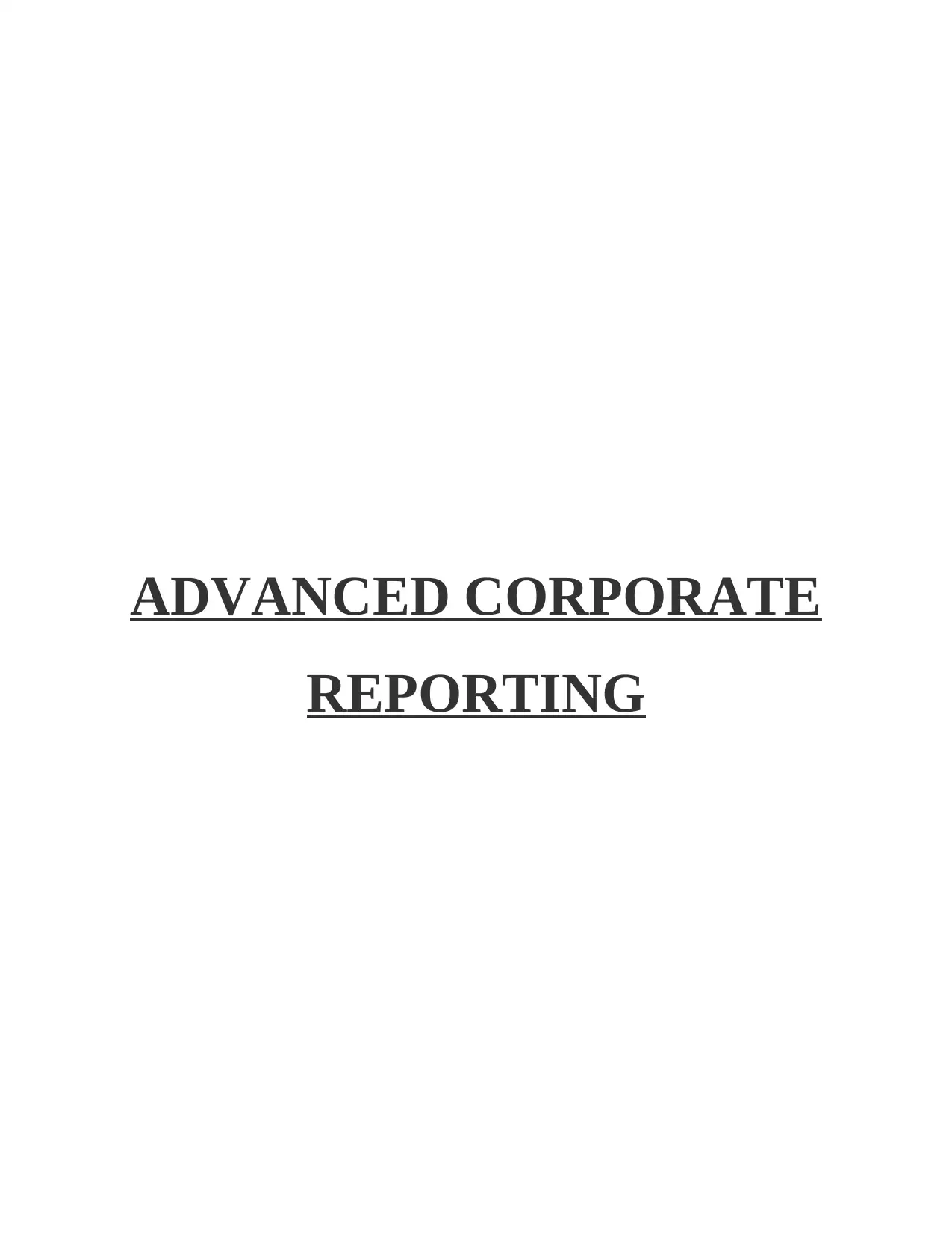
ADVANCED CORPORATE
REPORTING
REPORTING
Paraphrase This Document
Need a fresh take? Get an instant paraphrase of this document with our AI Paraphraser
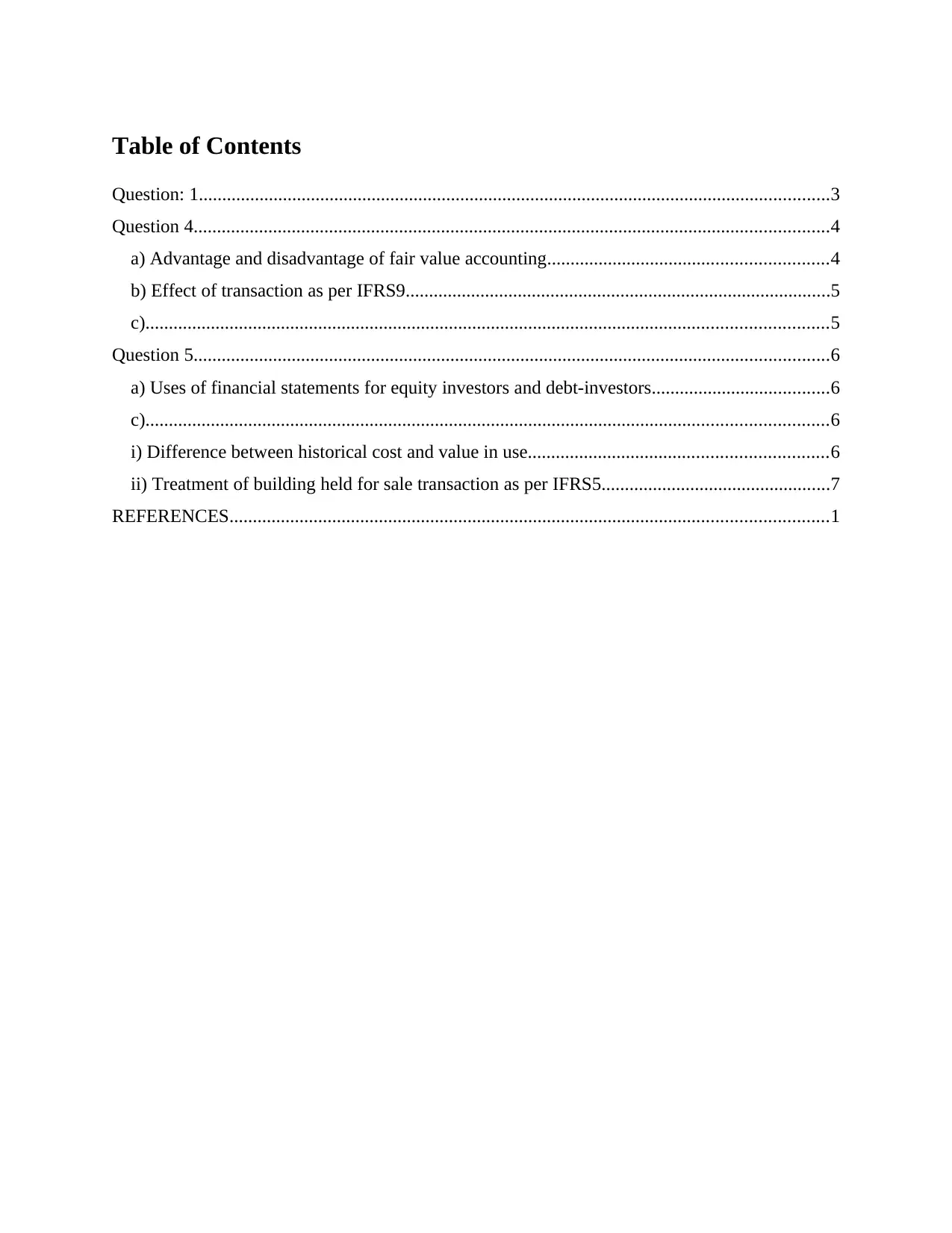
Table of Contents
Question: 1.......................................................................................................................................3
Question 4........................................................................................................................................4
a) Advantage and disadvantage of fair value accounting............................................................4
b) Effect of transaction as per IFRS9...........................................................................................5
c)..................................................................................................................................................5
Question 5........................................................................................................................................6
a) Uses of financial statements for equity investors and debt-investors......................................6
c)..................................................................................................................................................6
i) Difference between historical cost and value in use................................................................6
ii) Treatment of building held for sale transaction as per IFRS5.................................................7
REFERENCES................................................................................................................................1
Question: 1.......................................................................................................................................3
Question 4........................................................................................................................................4
a) Advantage and disadvantage of fair value accounting............................................................4
b) Effect of transaction as per IFRS9...........................................................................................5
c)..................................................................................................................................................5
Question 5........................................................................................................................................6
a) Uses of financial statements for equity investors and debt-investors......................................6
c)..................................................................................................................................................6
i) Difference between historical cost and value in use................................................................6
ii) Treatment of building held for sale transaction as per IFRS5.................................................7
REFERENCES................................................................................................................................1
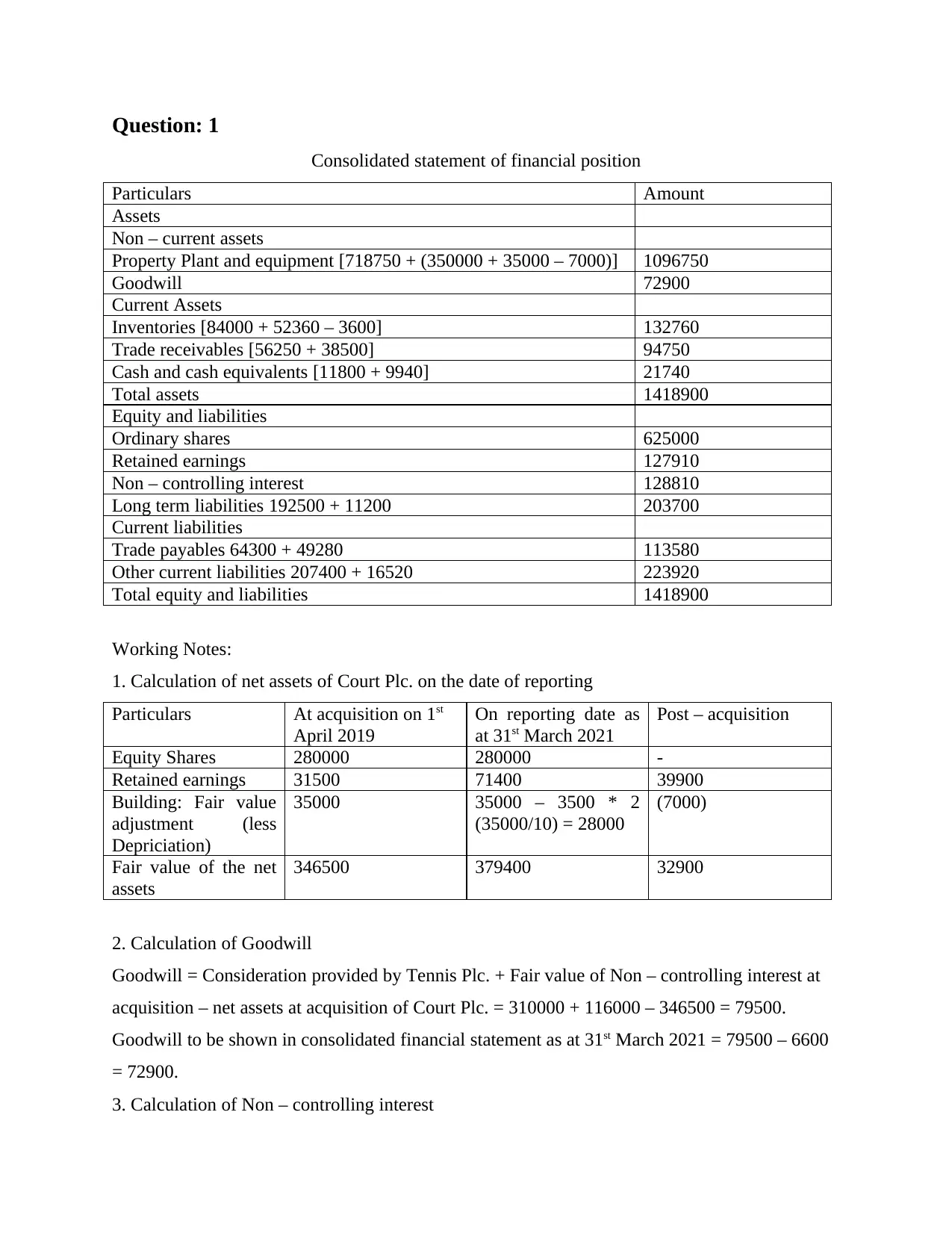
Question: 1
Consolidated statement of financial position
Particulars Amount
Assets
Non – current assets
Property Plant and equipment [718750 + (350000 + 35000 – 7000)] 1096750
Goodwill 72900
Current Assets
Inventories [84000 + 52360 – 3600] 132760
Trade receivables [56250 + 38500] 94750
Cash and cash equivalents [11800 + 9940] 21740
Total assets 1418900
Equity and liabilities
Ordinary shares 625000
Retained earnings 127910
Non – controlling interest 128810
Long term liabilities 192500 + 11200 203700
Current liabilities
Trade payables 64300 + 49280 113580
Other current liabilities 207400 + 16520 223920
Total equity and liabilities 1418900
Working Notes:
1. Calculation of net assets of Court Plc. on the date of reporting
Particulars At acquisition on 1st
April 2019
On reporting date as
at 31st March 2021
Post – acquisition
Equity Shares 280000 280000 -
Retained earnings 31500 71400 39900
Building: Fair value
adjustment (less
Depriciation)
35000 35000 – 3500 * 2
(35000/10) = 28000
(7000)
Fair value of the net
assets
346500 379400 32900
2. Calculation of Goodwill
Goodwill = Consideration provided by Tennis Plc. + Fair value of Non – controlling interest at
acquisition – net assets at acquisition of Court Plc. = 310000 + 116000 – 346500 = 79500.
Goodwill to be shown in consolidated financial statement as at 31st March 2021 = 79500 – 6600
= 72900.
3. Calculation of Non – controlling interest
Consolidated statement of financial position
Particulars Amount
Assets
Non – current assets
Property Plant and equipment [718750 + (350000 + 35000 – 7000)] 1096750
Goodwill 72900
Current Assets
Inventories [84000 + 52360 – 3600] 132760
Trade receivables [56250 + 38500] 94750
Cash and cash equivalents [11800 + 9940] 21740
Total assets 1418900
Equity and liabilities
Ordinary shares 625000
Retained earnings 127910
Non – controlling interest 128810
Long term liabilities 192500 + 11200 203700
Current liabilities
Trade payables 64300 + 49280 113580
Other current liabilities 207400 + 16520 223920
Total equity and liabilities 1418900
Working Notes:
1. Calculation of net assets of Court Plc. on the date of reporting
Particulars At acquisition on 1st
April 2019
On reporting date as
at 31st March 2021
Post – acquisition
Equity Shares 280000 280000 -
Retained earnings 31500 71400 39900
Building: Fair value
adjustment (less
Depriciation)
35000 35000 – 3500 * 2
(35000/10) = 28000
(7000)
Fair value of the net
assets
346500 379400 32900
2. Calculation of Goodwill
Goodwill = Consideration provided by Tennis Plc. + Fair value of Non – controlling interest at
acquisition – net assets at acquisition of Court Plc. = 310000 + 116000 – 346500 = 79500.
Goodwill to be shown in consolidated financial statement as at 31st March 2021 = 79500 – 6600
= 72900.
3. Calculation of Non – controlling interest
⊘ This is a preview!⊘
Do you want full access?
Subscribe today to unlock all pages.

Trusted by 1+ million students worldwide
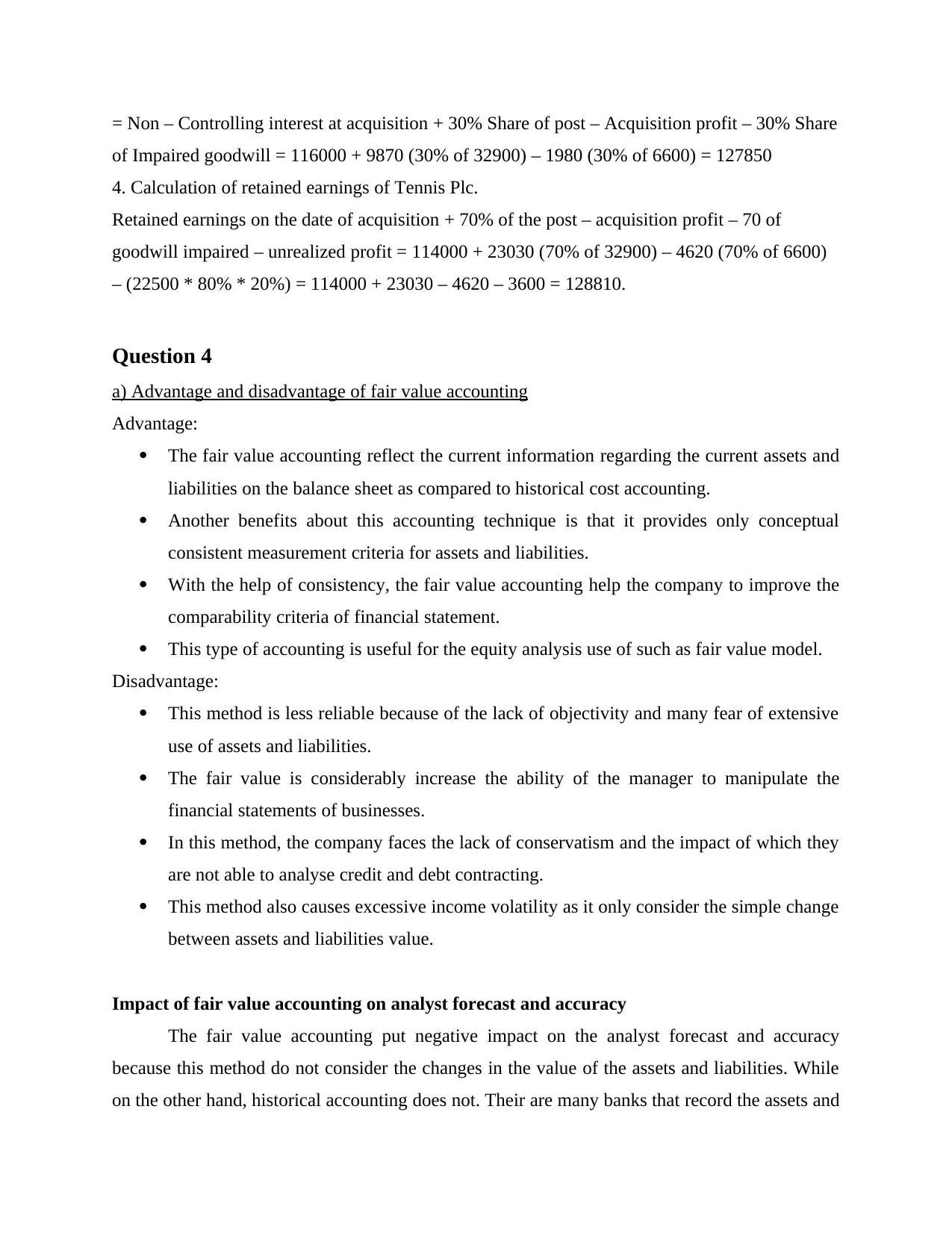
= Non – Controlling interest at acquisition + 30% Share of post – Acquisition profit – 30% Share
of Impaired goodwill = 116000 + 9870 (30% of 32900) – 1980 (30% of 6600) = 127850
4. Calculation of retained earnings of Tennis Plc.
Retained earnings on the date of acquisition + 70% of the post – acquisition profit – 70 of
goodwill impaired – unrealized profit = 114000 + 23030 (70% of 32900) – 4620 (70% of 6600)
– (22500 * 80% * 20%) = 114000 + 23030 – 4620 – 3600 = 128810.
Question 4
a) Advantage and disadvantage of fair value accounting
Advantage:
The fair value accounting reflect the current information regarding the current assets and
liabilities on the balance sheet as compared to historical cost accounting.
Another benefits about this accounting technique is that it provides only conceptual
consistent measurement criteria for assets and liabilities.
With the help of consistency, the fair value accounting help the company to improve the
comparability criteria of financial statement.
This type of accounting is useful for the equity analysis use of such as fair value model.
Disadvantage:
This method is less reliable because of the lack of objectivity and many fear of extensive
use of assets and liabilities.
The fair value is considerably increase the ability of the manager to manipulate the
financial statements of businesses.
In this method, the company faces the lack of conservatism and the impact of which they
are not able to analyse credit and debt contracting.
This method also causes excessive income volatility as it only consider the simple change
between assets and liabilities value.
Impact of fair value accounting on analyst forecast and accuracy
The fair value accounting put negative impact on the analyst forecast and accuracy
because this method do not consider the changes in the value of the assets and liabilities. While
on the other hand, historical accounting does not. Their are many banks that record the assets and
of Impaired goodwill = 116000 + 9870 (30% of 32900) – 1980 (30% of 6600) = 127850
4. Calculation of retained earnings of Tennis Plc.
Retained earnings on the date of acquisition + 70% of the post – acquisition profit – 70 of
goodwill impaired – unrealized profit = 114000 + 23030 (70% of 32900) – 4620 (70% of 6600)
– (22500 * 80% * 20%) = 114000 + 23030 – 4620 – 3600 = 128810.
Question 4
a) Advantage and disadvantage of fair value accounting
Advantage:
The fair value accounting reflect the current information regarding the current assets and
liabilities on the balance sheet as compared to historical cost accounting.
Another benefits about this accounting technique is that it provides only conceptual
consistent measurement criteria for assets and liabilities.
With the help of consistency, the fair value accounting help the company to improve the
comparability criteria of financial statement.
This type of accounting is useful for the equity analysis use of such as fair value model.
Disadvantage:
This method is less reliable because of the lack of objectivity and many fear of extensive
use of assets and liabilities.
The fair value is considerably increase the ability of the manager to manipulate the
financial statements of businesses.
In this method, the company faces the lack of conservatism and the impact of which they
are not able to analyse credit and debt contracting.
This method also causes excessive income volatility as it only consider the simple change
between assets and liabilities value.
Impact of fair value accounting on analyst forecast and accuracy
The fair value accounting put negative impact on the analyst forecast and accuracy
because this method do not consider the changes in the value of the assets and liabilities. While
on the other hand, historical accounting does not. Their are many banks that record the assets and
Paraphrase This Document
Need a fresh take? Get an instant paraphrase of this document with our AI Paraphraser
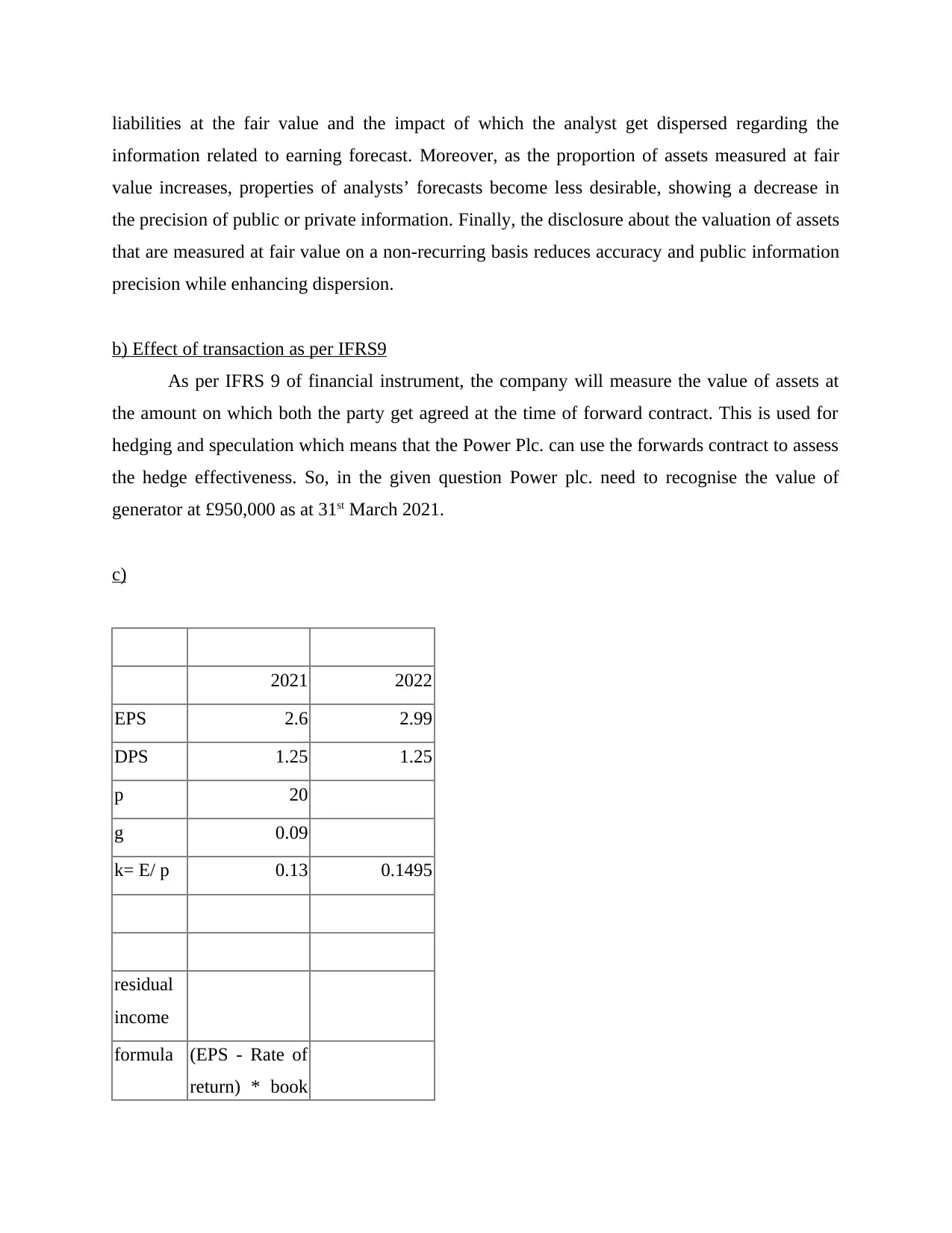
liabilities at the fair value and the impact of which the analyst get dispersed regarding the
information related to earning forecast. Moreover, as the proportion of assets measured at fair
value increases, properties of analysts’ forecasts become less desirable, showing a decrease in
the precision of public or private information. Finally, the disclosure about the valuation of assets
that are measured at fair value on a non-recurring basis reduces accuracy and public information
precision while enhancing dispersion.
b) Effect of transaction as per IFRS9
As per IFRS 9 of financial instrument, the company will measure the value of assets at
the amount on which both the party get agreed at the time of forward contract. This is used for
hedging and speculation which means that the Power Plc. can use the forwards contract to assess
the hedge effectiveness. So, in the given question Power plc. need to recognise the value of
generator at £950,000 as at 31st March 2021.
c)
2021 2022
EPS 2.6 2.99
DPS 1.25 1.25
p 20
g 0.09
k= E/ p 0.13 0.1495
residual
income
formula (EPS - Rate of
return) * book
information related to earning forecast. Moreover, as the proportion of assets measured at fair
value increases, properties of analysts’ forecasts become less desirable, showing a decrease in
the precision of public or private information. Finally, the disclosure about the valuation of assets
that are measured at fair value on a non-recurring basis reduces accuracy and public information
precision while enhancing dispersion.
b) Effect of transaction as per IFRS9
As per IFRS 9 of financial instrument, the company will measure the value of assets at
the amount on which both the party get agreed at the time of forward contract. This is used for
hedging and speculation which means that the Power Plc. can use the forwards contract to assess
the hedge effectiveness. So, in the given question Power plc. need to recognise the value of
generator at £950,000 as at 31st March 2021.
c)
2021 2022
EPS 2.6 2.99
DPS 1.25 1.25
p 20
g 0.09
k= E/ p 0.13 0.1495
residual
income
formula (EPS - Rate of
return) * book
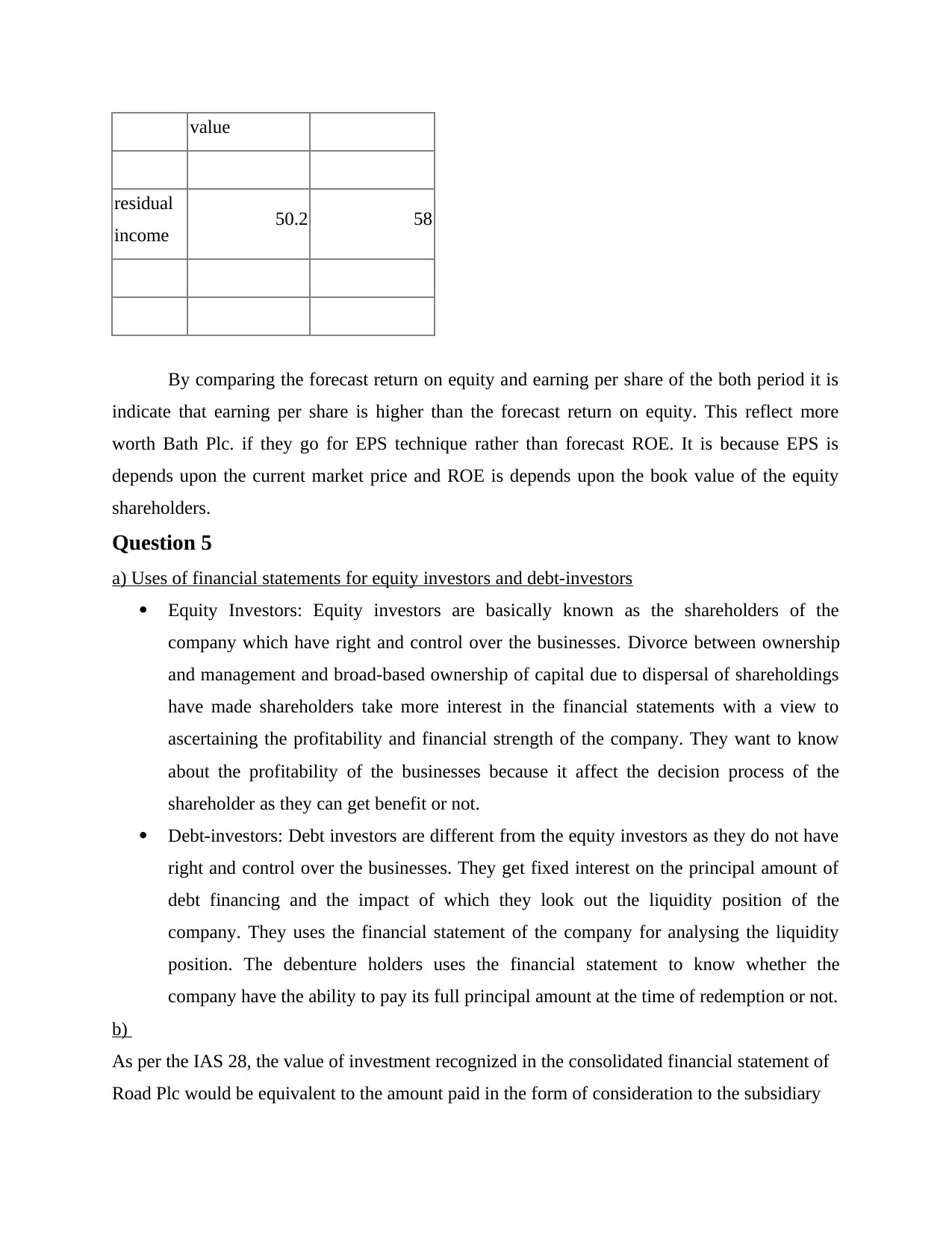
value
residual
income 50.2 58
By comparing the forecast return on equity and earning per share of the both period it is
indicate that earning per share is higher than the forecast return on equity. This reflect more
worth Bath Plc. if they go for EPS technique rather than forecast ROE. It is because EPS is
depends upon the current market price and ROE is depends upon the book value of the equity
shareholders.
Question 5
a) Uses of financial statements for equity investors and debt-investors
Equity Investors: Equity investors are basically known as the shareholders of the
company which have right and control over the businesses. Divorce between ownership
and management and broad-based ownership of capital due to dispersal of shareholdings
have made shareholders take more interest in the financial statements with a view to
ascertaining the profitability and financial strength of the company. They want to know
about the profitability of the businesses because it affect the decision process of the
shareholder as they can get benefit or not.
Debt-investors: Debt investors are different from the equity investors as they do not have
right and control over the businesses. They get fixed interest on the principal amount of
debt financing and the impact of which they look out the liquidity position of the
company. They uses the financial statement of the company for analysing the liquidity
position. The debenture holders uses the financial statement to know whether the
company have the ability to pay its full principal amount at the time of redemption or not.
b)
As per the IAS 28, the value of investment recognized in the consolidated financial statement of
Road Plc would be equivalent to the amount paid in the form of consideration to the subsidiary
residual
income 50.2 58
By comparing the forecast return on equity and earning per share of the both period it is
indicate that earning per share is higher than the forecast return on equity. This reflect more
worth Bath Plc. if they go for EPS technique rather than forecast ROE. It is because EPS is
depends upon the current market price and ROE is depends upon the book value of the equity
shareholders.
Question 5
a) Uses of financial statements for equity investors and debt-investors
Equity Investors: Equity investors are basically known as the shareholders of the
company which have right and control over the businesses. Divorce between ownership
and management and broad-based ownership of capital due to dispersal of shareholdings
have made shareholders take more interest in the financial statements with a view to
ascertaining the profitability and financial strength of the company. They want to know
about the profitability of the businesses because it affect the decision process of the
shareholder as they can get benefit or not.
Debt-investors: Debt investors are different from the equity investors as they do not have
right and control over the businesses. They get fixed interest on the principal amount of
debt financing and the impact of which they look out the liquidity position of the
company. They uses the financial statement of the company for analysing the liquidity
position. The debenture holders uses the financial statement to know whether the
company have the ability to pay its full principal amount at the time of redemption or not.
b)
As per the IAS 28, the value of investment recognized in the consolidated financial statement of
Road Plc would be equivalent to the amount paid in the form of consideration to the subsidiary
⊘ This is a preview!⊘
Do you want full access?
Subscribe today to unlock all pages.

Trusted by 1+ million students worldwide
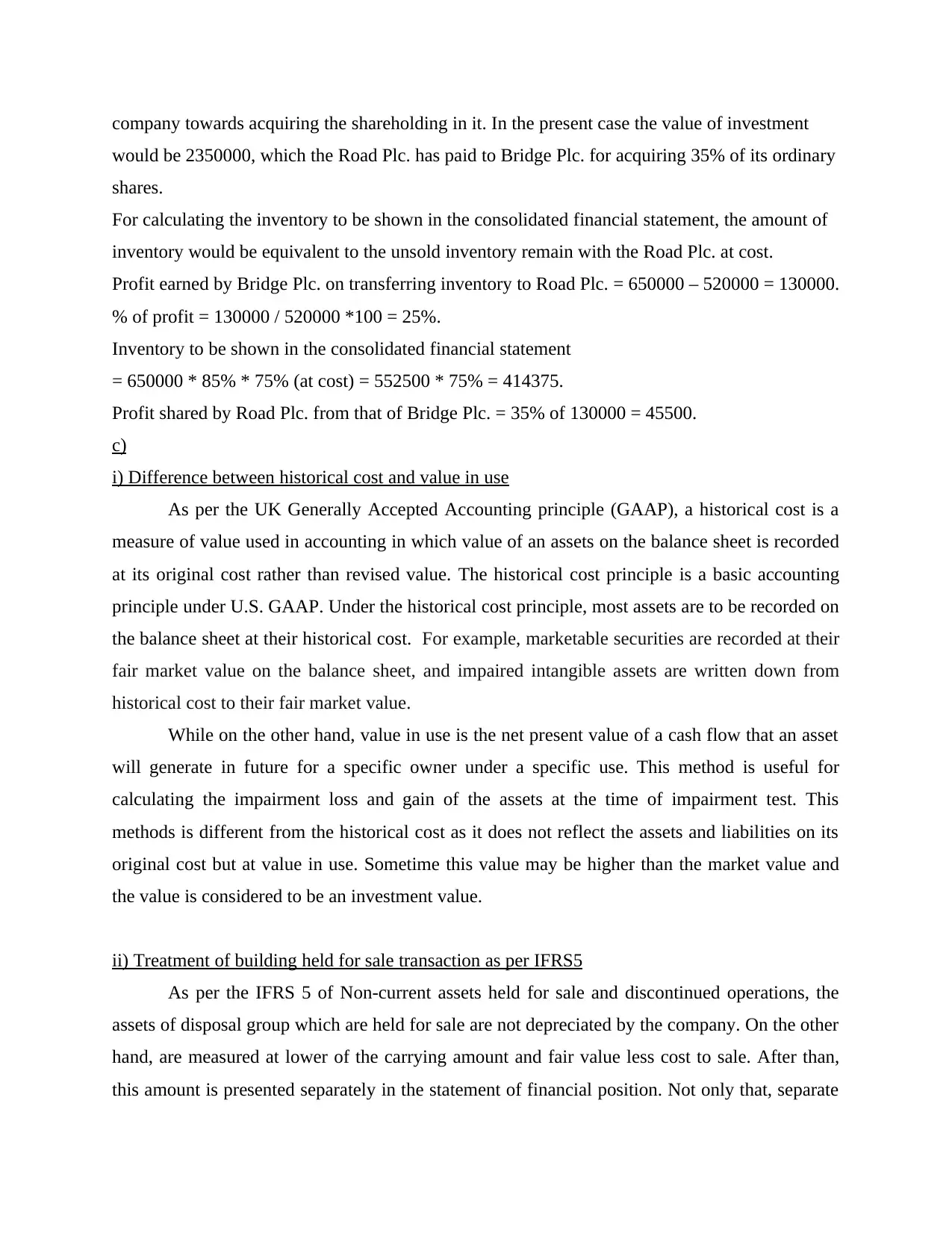
company towards acquiring the shareholding in it. In the present case the value of investment
would be 2350000, which the Road Plc. has paid to Bridge Plc. for acquiring 35% of its ordinary
shares.
For calculating the inventory to be shown in the consolidated financial statement, the amount of
inventory would be equivalent to the unsold inventory remain with the Road Plc. at cost.
Profit earned by Bridge Plc. on transferring inventory to Road Plc. = 650000 – 520000 = 130000.
% of profit = 130000 / 520000 *100 = 25%.
Inventory to be shown in the consolidated financial statement
= 650000 * 85% * 75% (at cost) = 552500 * 75% = 414375.
Profit shared by Road Plc. from that of Bridge Plc. = 35% of 130000 = 45500.
c)
i) Difference between historical cost and value in use
As per the UK Generally Accepted Accounting principle (GAAP), a historical cost is a
measure of value used in accounting in which value of an assets on the balance sheet is recorded
at its original cost rather than revised value. The historical cost principle is a basic accounting
principle under U.S. GAAP. Under the historical cost principle, most assets are to be recorded on
the balance sheet at their historical cost. For example, marketable securities are recorded at their
fair market value on the balance sheet, and impaired intangible assets are written down from
historical cost to their fair market value.
While on the other hand, value in use is the net present value of a cash flow that an asset
will generate in future for a specific owner under a specific use. This method is useful for
calculating the impairment loss and gain of the assets at the time of impairment test. This
methods is different from the historical cost as it does not reflect the assets and liabilities on its
original cost but at value in use. Sometime this value may be higher than the market value and
the value is considered to be an investment value.
ii) Treatment of building held for sale transaction as per IFRS5
As per the IFRS 5 of Non-current assets held for sale and discontinued operations, the
assets of disposal group which are held for sale are not depreciated by the company. On the other
hand, are measured at lower of the carrying amount and fair value less cost to sale. After than,
this amount is presented separately in the statement of financial position. Not only that, separate
would be 2350000, which the Road Plc. has paid to Bridge Plc. for acquiring 35% of its ordinary
shares.
For calculating the inventory to be shown in the consolidated financial statement, the amount of
inventory would be equivalent to the unsold inventory remain with the Road Plc. at cost.
Profit earned by Bridge Plc. on transferring inventory to Road Plc. = 650000 – 520000 = 130000.
% of profit = 130000 / 520000 *100 = 25%.
Inventory to be shown in the consolidated financial statement
= 650000 * 85% * 75% (at cost) = 552500 * 75% = 414375.
Profit shared by Road Plc. from that of Bridge Plc. = 35% of 130000 = 45500.
c)
i) Difference between historical cost and value in use
As per the UK Generally Accepted Accounting principle (GAAP), a historical cost is a
measure of value used in accounting in which value of an assets on the balance sheet is recorded
at its original cost rather than revised value. The historical cost principle is a basic accounting
principle under U.S. GAAP. Under the historical cost principle, most assets are to be recorded on
the balance sheet at their historical cost. For example, marketable securities are recorded at their
fair market value on the balance sheet, and impaired intangible assets are written down from
historical cost to their fair market value.
While on the other hand, value in use is the net present value of a cash flow that an asset
will generate in future for a specific owner under a specific use. This method is useful for
calculating the impairment loss and gain of the assets at the time of impairment test. This
methods is different from the historical cost as it does not reflect the assets and liabilities on its
original cost but at value in use. Sometime this value may be higher than the market value and
the value is considered to be an investment value.
ii) Treatment of building held for sale transaction as per IFRS5
As per the IFRS 5 of Non-current assets held for sale and discontinued operations, the
assets of disposal group which are held for sale are not depreciated by the company. On the other
hand, are measured at lower of the carrying amount and fair value less cost to sale. After than,
this amount is presented separately in the statement of financial position. Not only that, separate
Paraphrase This Document
Need a fresh take? Get an instant paraphrase of this document with our AI Paraphraser

discloser is also required for the discontinued operation and disposal of non current assets. So,
here the company will need to follow above mentioned provision for this transaction treatment.
here the company will need to follow above mentioned provision for this transaction treatment.
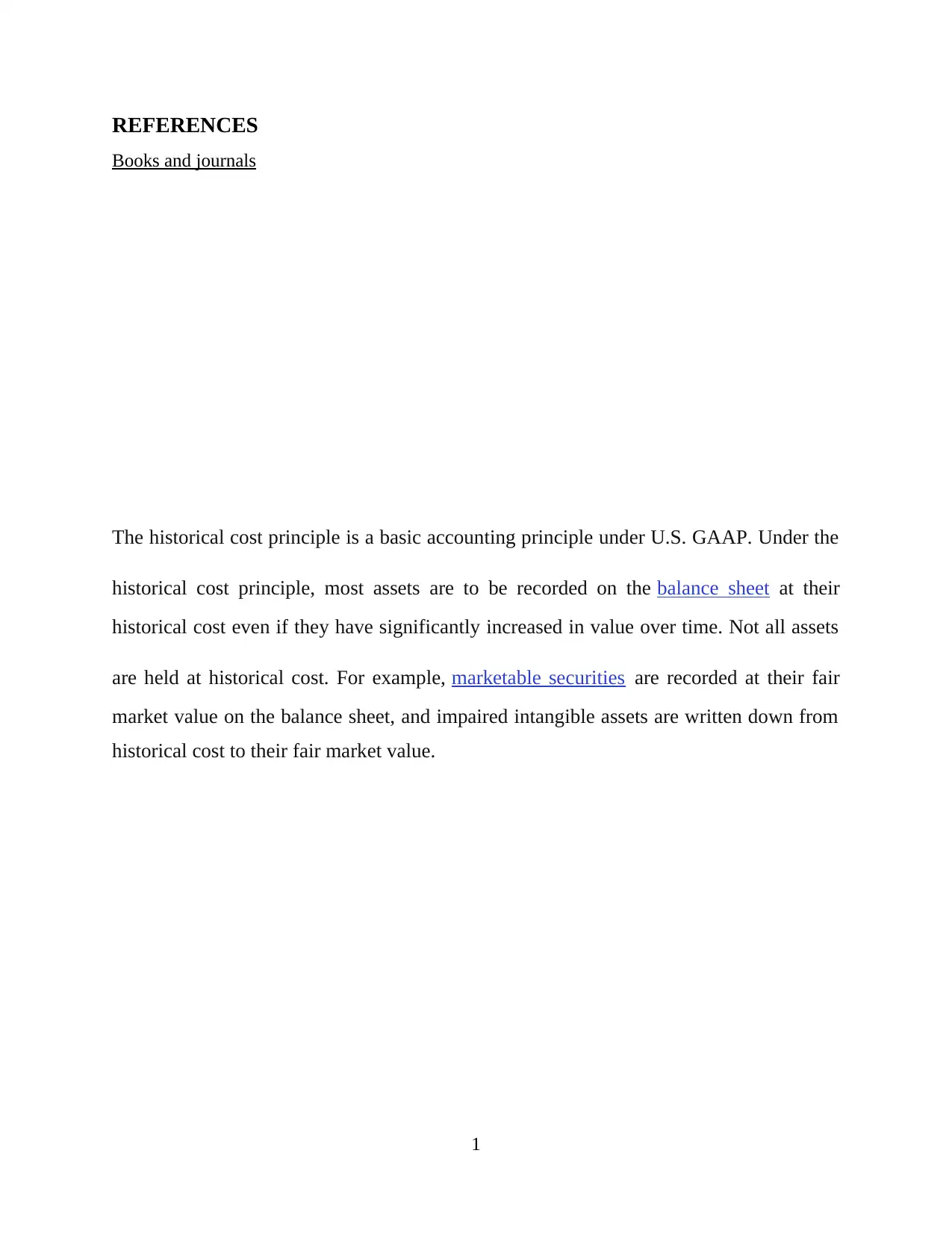
REFERENCES
Books and journals
The historical cost principle is a basic accounting principle under U.S. GAAP. Under the
historical cost principle, most assets are to be recorded on the balance sheet at their
historical cost even if they have significantly increased in value over time. Not all assets
are held at historical cost. For example, marketable securities are recorded at their fair
market value on the balance sheet, and impaired intangible assets are written down from
historical cost to their fair market value.
1
Books and journals
The historical cost principle is a basic accounting principle under U.S. GAAP. Under the
historical cost principle, most assets are to be recorded on the balance sheet at their
historical cost even if they have significantly increased in value over time. Not all assets
are held at historical cost. For example, marketable securities are recorded at their fair
market value on the balance sheet, and impaired intangible assets are written down from
historical cost to their fair market value.
1
⊘ This is a preview!⊘
Do you want full access?
Subscribe today to unlock all pages.

Trusted by 1+ million students worldwide
1 out of 9
Related Documents
Your All-in-One AI-Powered Toolkit for Academic Success.
+13062052269
info@desklib.com
Available 24*7 on WhatsApp / Email
![[object Object]](/_next/static/media/star-bottom.7253800d.svg)
Unlock your academic potential
Copyright © 2020–2025 A2Z Services. All Rights Reserved. Developed and managed by ZUCOL.




